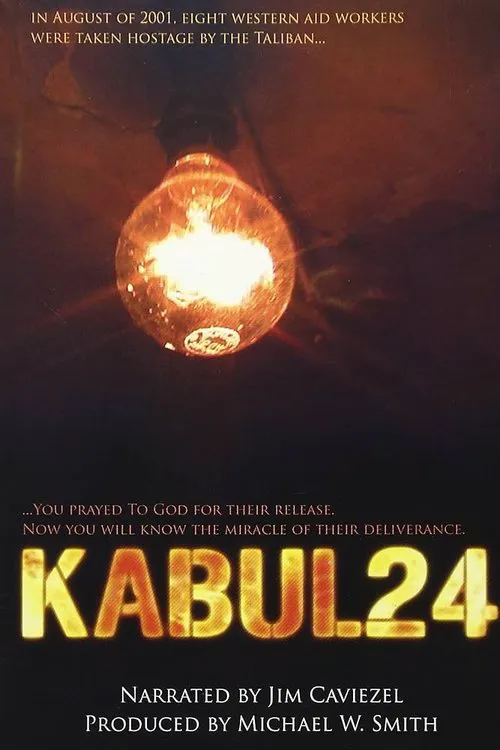Kabul 24

Enredo
In the sweltering summer of 2001, four aid workers from Shelter Now International, a German-based humanitarian organization, embarked on a mission to help the people of Afghanistan. The team consisted of three Germans, Susanne Osthoff, Inge Senger, and Dieter Zehentbauer, along with Australian couple Aidan and Patricia Grossmann. Their journey, however, would take an ominous turn as they became entangled in a complex web of international politics and the brewing tension between the United States and Afghanistan. The team arrived in the war-torn nation with high hopes of bringing aid and relief to those in need. They were not only Christians but also committed aid workers, driven by a sense of compassion and a desire to make a difference. Initially, they worked in close proximity with their Afghan colleagues, who were also Muslims, but as time passed, the atmosphere began to shift. The capture of the World Trade Center in 1998 and the subsequent rise of the Taliban's radical ideology created a climate of suspicion and hostility. On August 2, 2001, the Taliban, sensing the looming threat of the United States, orchestrated a calculated move to create a propaganda coup. They stormed the shelter compound, accusing the group of converting to Christianity, a charge they vehemently denied. The Taliban, seeking to exploit the situation for their own gain, seized the four aid workers, along with 20 Afghan staff members, claiming they were spies working for the CIA or other Western intelligence agencies. The 24 hostages, men and women, were thrown into a bleak, unfurnished room in the infamous Pul-e Charkhi prison. The Taliban, determined to break their spirits, subjected them to relentless interrogation, often using physical and verbal abuse to extract confessions. The captives endured sleep deprivation, beatings, and psychological manipulation, all in an effort to force them to renounce their faith and confess to espionage. As the weeks dragged on, the world was shocked by the news of the hostages' capture. Governments and organizations from the United States, Australia, Germany, and Afghanistan scrambled to negotiate their release. The Australian and German governments, in particular, worked tirelessly to secure the hostages' freedom, but to no avail. The Taliban, playing a cat-and-mouse game, refused to budge, even as the threat of US military intervention grew. The hostages' situation worsened as the Taliban Supreme Court convened a sham trial. The captives were presented with false evidence, including photographs of Christian symbols and literature, and forced to admit to crimes they had not committed. The kangaroo court verdict, predictably, condemned the hostages to either execution or life imprisonment. The world watched in horror as the Taliban's brutal tactics were exposed. Aid workers, innocent civilians, and humanitarian organizations spoke out against the Taliban's inhumane treatment of the captives. The international community condemned the abuse, and public pressure mounted, but the Taliban refused to bow. As the stakes grew higher, Kabul teetered on the brink of chaos. The US-led coalition was poised to strike, and the Taliban's hold on the city faltered. In the midst of this turmoil, the hostages were forced to endure the consequences of the war. They huddled together in their cell, praying for deliverance as the bombing of Kabul intensified. The sounds of explosions and gunfire pierced the night, casting a sense of hopelessness over the captives. In the darkest moments, the hostages' faith was tested, but they clung to each other, drawing strength from their shared ordeal. Inge Senger, Dieter Zehentbauer, and Susanne Osthoff, all devout Christians, encouraged one another, knowing that their imprisonment was not a punishment but an opportunity to demonstrate the love and forgiveness of Christ. Patricia and Aidan Grossman, the Australian couple, provided unwavering support to the others, drawing on their combined 60 years of marriage. The couples' bonds grew stronger as they weathered the ordeals together. Despite the hardships, they refused to give up, praying for their freedom and a swift end to the conflict. The hostages' ordeal lasted 105 excruciating days, a period that tested their resolve, their faith, and their humanity. As they endured the physical and emotional abuse, they found solace in each other's company and in the unwavering support of their families and loved ones. Miraculously, on November 19, 2001, just as the US-led coalition was poised to invade, the Afghan government successfully negotiated the release of the hostages. As they emerged from their prison cell, blinking in the bright sunlight, the captives knew they would never be the same. The 105 days they had spent in captivity had changed them forever, leaving behind a deeper understanding of faith, compassion, and the resilience of the human spirit.
Resenhas
Recomendações


